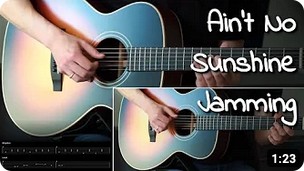Basic major chords
Below are the most basic major chords. Most of these chord shapes are open chord shapes, which means that not all strings are fretted. More advanced major chord shapes that can be moved around the neck will be discussed later.
Major chords have a bright and happy sound. They are made up of three notes: the root note, the major third (root note + 4 semitones) and the perfect fifth (root note + 7 semitones). Here is help on how to read chord diagrams.
C major

‣ The low E string is not part of the C major chord shape, so make sure it is muted.
D major

‣ The low E and A strings are not part of the D major chord shape, so make sure they are muted.
E major

F major




‣ F major variation 1 is the simplest version of F major. The low E and A strings are not part of this chord shape, so make sure they are muted. If you want a fuller sound, variation 2 or 3 is recommended. Variation 2 is a barre chord, while variation 3 is played with the thumb over the neck. I personally prefer variation 3 because my wrist hurts quickly when playing barre chords. I also discussed this topic in my text about body posture and hand positioning. Variation 4 is often used in fingerstyle guitar because it offers a simple advantage: The pinky is free to fret additional melody notes. The disadvantage of variation 4 is that you need to mute the A string because it is not part of the chord shape.



G major



‣ Most people learn G major variation 2 or 3 in the beginning. I personally use variation 1 almost exclusively, because it offers some advantages: Whenever you play G major, chances are that you will play C major or F major afterwards. Changing from G major variation 1 to C major or F major is much easier than changing from the other variations of G major. The same applies when changing from C major or F major to G major.
A major



‣ The low E string is not part of the A major chord shape, so make sure it is muted. Whether you prefer A major variation 1 or variation 2 is more a matter of taste. Most people stick with the fingering they learned first. Variation 3 (sometimes called "long A") is widely used in fingerstyle because it offers some nice melody playing options with the pinky while the index finger bars the bottom four strings.

